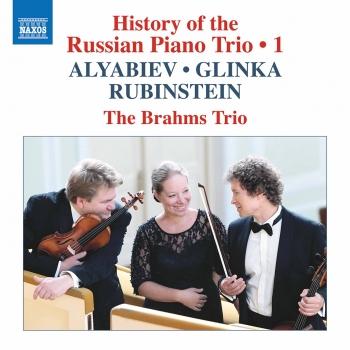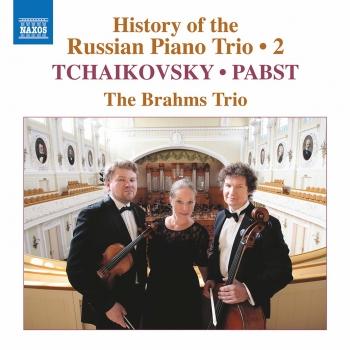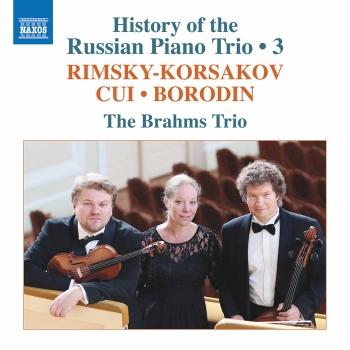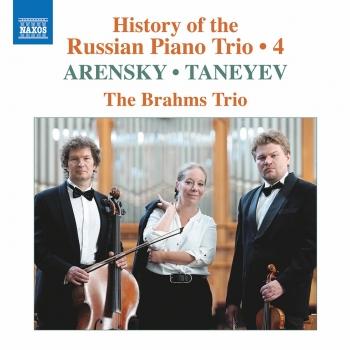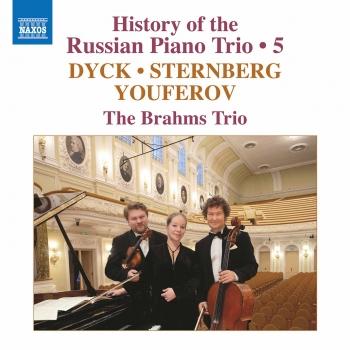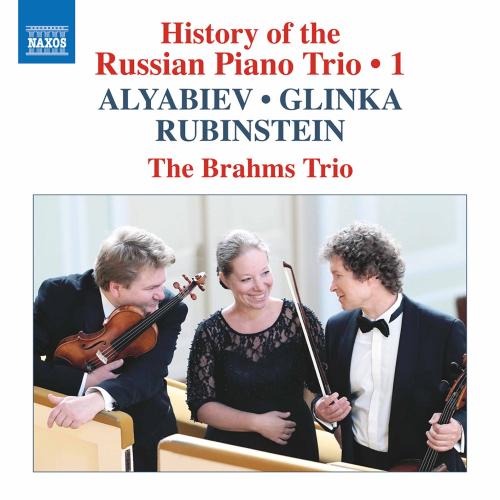
History of the Russian Piano Trio, Vol. 1 Brahms Trio
Album info
Album-Release:
2020
HRA-Release:
13.11.2020
Label: Naxos
Genre: Classical
Subgenre: Chamber Music
Artist: Brahms Trio
Composer: Alexander Alyabiev (1787-1851), Michael Glinka (1804-1857), Anton Rubinstein (1829-1894)
Album including Album cover Booklet (PDF)
- Alexander Alyabyev (1787 - 1851):
- 1 Piano Trio in E-Flat Major 10:04
- 2 Piano Trio in A Minor: I. Allegro ma non troppo 07:10
- 3 Piano Trio in A Minor: II. Adagio 03:44
- 4 Piano Trio in A Minor: III. Rondo. Allegretto 07:47
- Mikhail Glinka (1804 - 1857): Trio pathétique in D Minor (Arr. J. Hřímalý for Violin, Cello & Piano):
- 5 Trio pathétique in D Minor (Arr. J. Hřímalý for Violin, Cello & Piano): I. Allegro moderato 05:27
- 6 Trio pathétique in D Minor (Arr. J. Hřímalý for Violin, Cello & Piano): II. Scherzo. Vivacissimo 03:26
- 7 Trio pathétique in D Minor (Arr. J. Hřímalý for Violin, Cello & Piano): III. Largo 04:44
- 8 Trio pathétique in D Minor (Arr. J. Hřímalý for Piano Trio): IV. Allegro con spirito 02:11
- Anton Rubinstein (1829 - 1894): Piano Trio No. 2 in G Minor, Op. 15 No. 2:
- 9 Piano Trio No. 2 in G Minor, Op. 15 No. 2: I. Moderato 09:32
- 10 Piano Trio No. 2 in G Minor, Op. 15 No. 2: II. Adagio 08:46
- 11 Piano Trio No. 2 in G Minor, Op. 15 No. 2: III. Allegro assai 04:20
- 12 Piano Trio No. 2 in G Minor, Op. 15 No. 2: IV. Moderato 08:09
Info for History of the Russian Piano Trio, Vol. 1
The piano trio holds an important place in the history of Russian chamber music and to follow the development of the genre is to accompany the fascinating history of Russian music in the 19th century. Its beginnings can be found with Alexander Alyabiev, a student of John Field, whose unfinished but elegant and vivacious Piano Trio in E flat major is paired with the yearning Romanticism of the Piano Trio in A minor. Mikhail Glinka’s Trio pathétique bears the inscription ‘I have only known love through the sorrow it causes!’, while Anton Rubinstein’s elaborately acrobatic piano writing in his Piano Trio in G minor reminds us of his own virtuosity, and reveals his magnificent skills as a melodist.
Brahms Trio
Brahms Trio
"Brilliant artists who perfectly master all the musical capacities of their instruments, the members of the Brahms Trio also have those rare virtues that are necessary to achieve a real ensemble sound — modesty, flexibility, the desire and ability to hear each other, trust in the voice of the partner. That’s why the Brahms Trio’s performances are creating such incredible emotional power". (Maestro Rudolf Barshai)
Ever since its foundation more than twenty-five years ago, the Brahms Trio has been highly acclaimed for its outstanding artistry, often being called one of Russia’s leading chamber music ensembles. Right at the beginning of its career, in 1993, the Brahms Trio won the International Chamber Music Competition in Trapani, Italy, and in 1995 it was awarded the 1st Prize at the Joseph Joachim Chamber Music Competition in Weimar.
The Brahms Trio’s concert series, featuring chamber works by Brahms, Dvořák, Schubert, Beethoven, and Shostakovich, have gained the trio the highest recognition in hundreds of cities in Russia, Europe, Australia, South Korea, and Turkey. Since 2009, the Brahms Trio has opened every new concert season at the Moscow Conservatory. Critics praise the ‘clarity of the intentions, the singing softness of all three instruments, and a perfectly balanced sound’ (Wiener Zeitung, Austria), the ‘symphonic soundscape combined with the invariable nobleness of tone and the exquisite polyphony of musical texture which is characteristic of chamber music’ (Kultura, Russia).
Russian chamber music is the backbone of the repertoire performed by the Brahms Trio. Recognized as ‘the leading expert on Russian piano trios’ (Music Life Magazine, Russia), the Brahms Trio has performed concert series devoted to Russia’s chamber music heritage at the Tchaikovsky Conservatory in Moscow, the National Philharmonic Hall in Warsaw, the Royal Danish Academy of Music, the Stadtcasino Basel, Seoul Art Centre, and Brussels Town Hall, as well as at festivals in Melbourne, Hong Kong, Istanbul, Vienna, Paris, and London. After the Brahms Trio’s performance of the Trio in A minor by Tchaikovsky at the Brucknerhaus in Linz, Austrian critics wrote: ‘An awesome symphonic opus was represented by the prominent musicians with all the power of the tragic talent and brilliance of sound. [...] A colossal intensity! A masterpiece was born right under the eyes of a stunned audience,’ (Volksblatt, Austria). The Italian newspaper Il Monferrato acclaimed the premieres of the trios by Alyabyev and Pabst: ‘Performed by the Brahms Trio, these opuses, buried for so long in Russian score sheets, are destined for success.’ The Strad Magazine noted: ‘This splendid performance of Shostakovich’s Trio Op. 67, demonstrates irony, bitterness and humour, which are this work’s signature features.’
The premieres of piano trios composed in the Silver Age and the era of Russian Art Nouveau — works that miraculously survived the cataclysms of the 20th century and until recently remained unknown even to professional musicians — were an important part of the Brahms Trio’s missionary and educational project, the ’Russian Chamber Music Assemblies’, from 1998 to 2005 bringing the Brahms Trio to more than 100 cities of even the most remote parts of Siberia, Russia’s northern regions and the Far East. These numerous trips alongside one of the leading events in Moscow’s cultural calendar for two decades, the Art November festival, established by the Brahms Trio in 1994, have made an important contribution to Russia’s cultural renaissance at the turn of the 21st century.
In 2016, after years of research, archival and performing work, in the course of which the unique parts of the Russian cultural heritage were found and presented to the audience, the Brahms Trio compiled a catalogue of chamber music of the 18th, 19th, and 20th century, comprising more than 400 composers and about 1,500 works written by Russian composers in Russia and abroad. The same year the Brahms Trio started recording for the project ‘The History of Russian Piano Trios’, the first anthology of Russian piano trios to be published on CD. The anthology’s first series of five separate releases, focusing on music of the Russian Empire, includes alongside the tops of the chamber music repertoire — the trios of Tchaikovsky, Arensky, and Taneyev — the early works of Alyabyev, Glinka and Rubinstein as well as rare chamber pieces of the great Russian symphonists Rimsky-Korsakov and Borodin. This first set of CDs, that will be released to 2021 by Naxos, also features the world premiere recordings of works which, at different periods and for different reasons, had disappeared from the musical history: the piano trios of Paul Pabst, César Cui, Vladimir Dyck, Konstantin von Sternberg, and Sergei Youferov.
Disciples of the legendary chamber music class of Tatiana Gaidamovich and Alexander Bonduriansky at the Moscow Conservatory, the musicians of the Brahms Trio were acclaimed ‘musical descendants of Vasily Safonov, Leopold Auer, and Karl Davydov’ by The Moscow Times, ‘who have inherited the traditions of the Russian school of music performance and the sublime ideas of ‘cultural missionary outreach’, pioneered by Anton Rubinstein.’
The Brahms Trio was founded by pianist Natalia Rubinstein. Violinist Nikolai Sachenko and cellist Kirill Rodin — both are Winners of the Golden Medal of the International Tchaikovsky Competition (Moscow, 1998 and 1986) — joined the Brahms Trio in 2008. The members of the Brahms Trio are professors of the Moscow Conservatory, recipients of the awards For the Prominent Contribution to the Development of Culture and the title Honoured Artist of Russia.
Booklet for History of the Russian Piano Trio, Vol. 1










